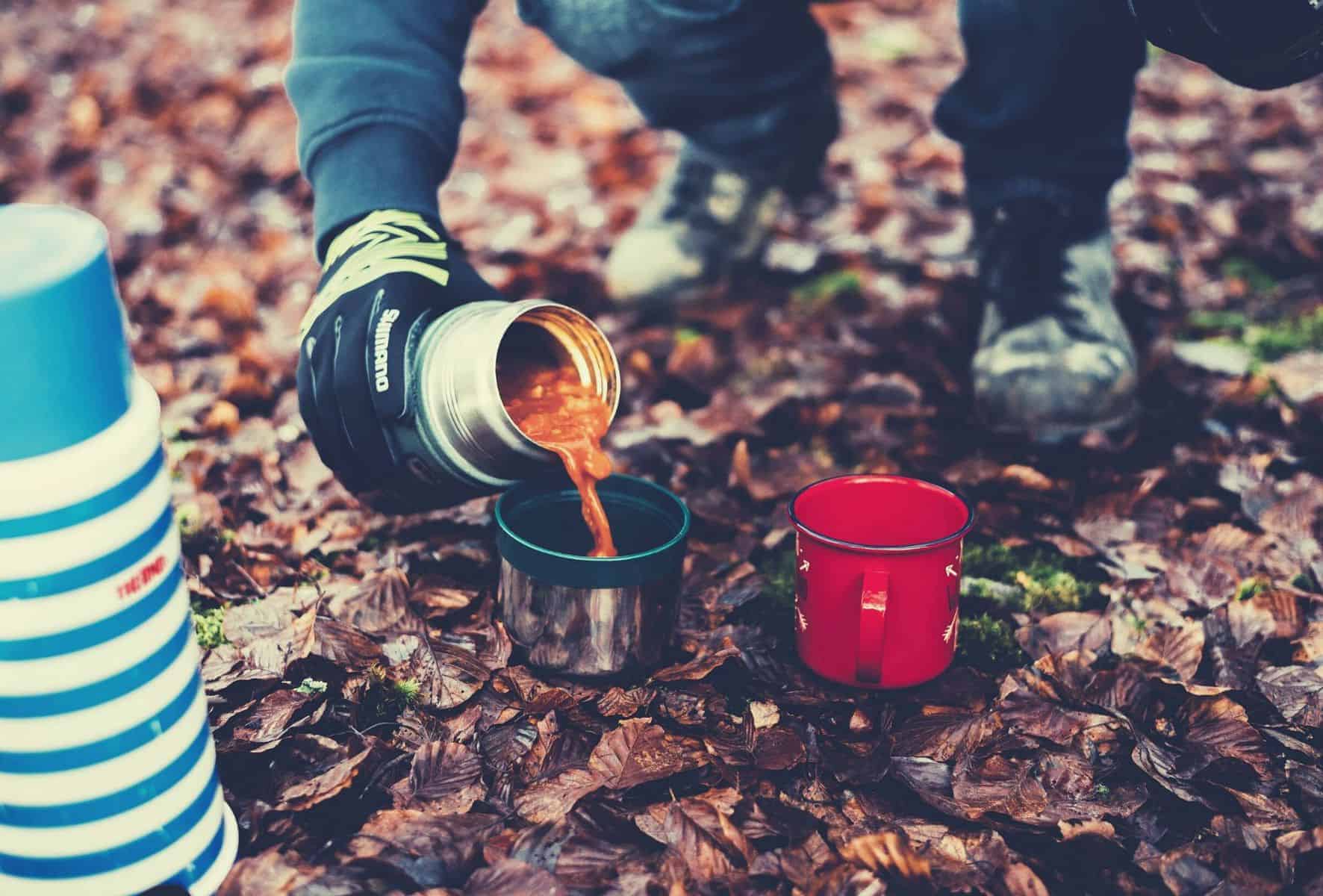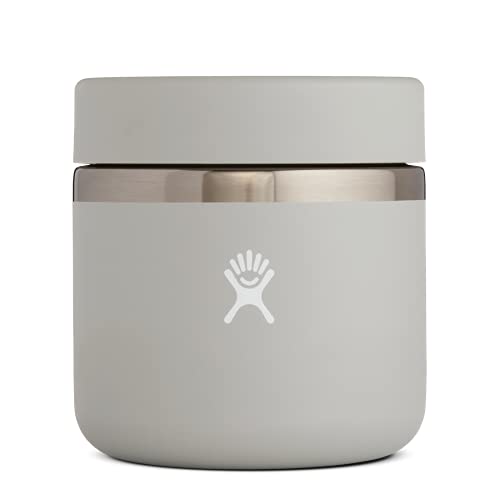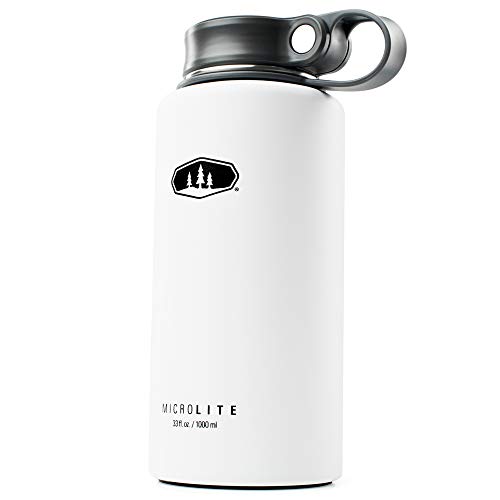If you’re tired of drinking tepid tea or warmed-up water on the trail, you’re not alone. After testing countless thermos brands, we’ve often been left disappointed. Our cold drinks lost their chill, and hot beverages cooled off within a few hours on the trail. Add an unreliable lid into the mix and you’ll understand the importance of selecting a high-quality thermos flask for your backcountry adventures.
That’s why we’ve rigorously tested dozens of bottles, from ultralight backpacking options to large-capacity choices for groups. The Klean Kanteen TKWide is crowned our overall winner but hot on its heels are the Zojirushi Thermos Mug, Primus Trailbreak EX, Stanley Classic, Thermos Stainless King 16-Ounce Food Jar, Hydro Flask 20-Ounce Food Flask, Thermos Stainless King 16oz Compact, Healthy Human Stein 16oz, and GSI Outdoors Microlite 1000 Twist.
To assist you in choosing the ideal option for your hiking needs, our thermos buying advice covers all the essential aspects to look out for. These include capacity, insulation, durability, leakproofing, as well as additional features such as easy-grip designs, interchangeable lids, carry straps, exterior covers, and built-in spoons.
Table of Contents
- What Are The Best Insulated Thermos Flasks?
- Klean Kanteen TKWide
- Zojirushi Stainless Steel Thermos Mug
- Primus Trailbreak EX Vacuum Bottle
- Stanley Classic Vacuum Bottle
- Thermos Stainless King 16-Ounce Food Jar
- Hydro Flask 20-Ounce Food Flask
- Thermos Stainless King 16oz Compact
- Healthy Human Stein 16oz
- GSI Outdoors Microlite 1000 Twist Vacuum Water Bottle
- What To Look For In A Thermal Thermos Flask?
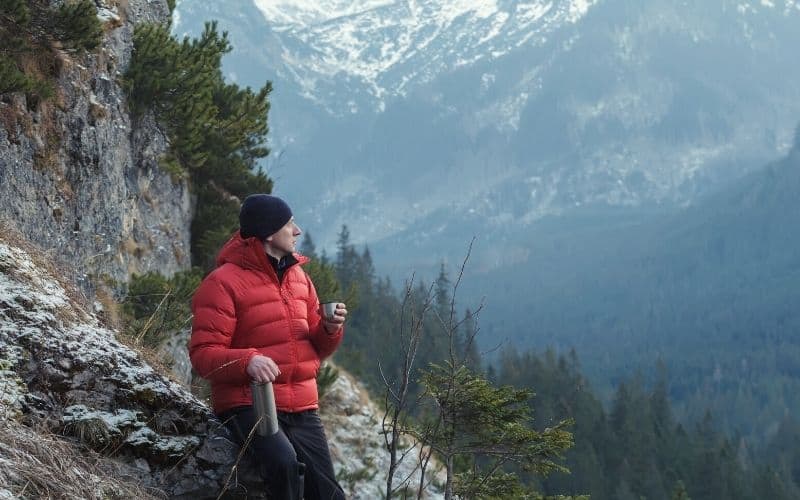
At a Glance: Best Thermoses
-
Editor’s Choice:
Klean Kanteen 16oz TKWide
“A simple, well-designed bottle that offers awesome heat retention and can keep water cold a little longer than most.” -
Best Value:
Zojirushi Stainless Steel Travel Mug
“A fairly priced and durable insulated bottle with a convenient, intelligently designed lid.” -
Best Camping Thermos:
Primus Trailbreak EX Vacuum Bottle
“A high-capacity, extra-tough stainless steel flask that can keep your brew warm or H2O cold for full days on the trail.” -
Best for Hot Drinks:
Stanley Classic Vacuum Bottle – 20 oz
“A burly, no-nonsense kinda flask that boasts the best heat retention of the bunch.” -
Best for Food:
Thermos Stainless King 16-Ounce Food Jar
“This ultralight insulated jar comes with a built-in serving bowl and full-sized spoon, making it the most practical food container on our list.” -
Best for Family Camping:
Hydro Flask 20-Ounce Food Flask
“A simple, frill-free, and highly effective food jar that’s ideal for ensuring larger hot lunches stay hot till dinner time.” -
Best for Backpacking:
Thermos Stainless King 16oz Compact
“This ultralight flask is ideal for long-distance hikers who like a hot drink for a morale boost along the way.” -
Best Budget:
Healthy Human Stein 16oz
“A sleek, award-winning bottle that’s just a little more practical than the best of the rest.” -
Best High-Capacity:
GSI Outdoors Microlite 1000 Twist Vacuum Water Bottle
“This flask’s 1-liter capacity makes it the best option on our list for peeps with larger appetites or trips with all the family.”
What Are The Best Insulated Thermos Flasks?
After extensive research and testing of the top insulated thermos bottles, we’ve narrowed it down to our top nine as listed below.
- Klean Kanteen TKWide
- Zojirushi Stainless Steel Thermos Mug
- Primus Trailbreak EX Vacuum Bottle
- Stanley Classic Vacuum Bottle
- Thermos Stainless King 16-Ounce Food Jar
- Hydro Flask 20-Ounce Food Flask
- Thermos Stainless King 16oz Compact
- Healthy Human Stein 16oz
- GSI Outdoors Microlite 1000 Twist Vacuum Water Bottle
Klean Kanteen TKWide
Editor’s ChoiceThe Klean Kanteen TK Wide won our editor’s choice award, it’s versatile, tough, relatively lightweight, and above all reliable.
Makers KK claim this bottle can keep drinks hot for 14 hours and cold for 47 hours. In practice, we found those figures to be more like 10-12 hours for hot drinks and 35-40 hours for cold drinks, which is still mightily impressive.
Although we’d opt for an out-and-out coffee thermos like the Stanley Classic for hot beverages, this one wins our best-in-class award for its sleek, sturdy design, convenient lids, and ability to keep water icy cold longer than any other insulated bottle we know of.
This bottle comes with two practical lids. A “Twist Cap” with built-in reusable straw and a leakproof “Café Cap” with a swivel loop for easy transportation. The colored versions of this bottle also have a matte finish that provides a little extra grip for easy handling.
PROs
- Keeps drink hot for up to 10-12 hours and cold for 35-40 hours
- Fits most cup holders
- Internal thread design increases thermal performance
- Leakproof Café Cap with easy-carry swivel loop
- Dishwasher safe
- Compatible with Twist Cap, Chug Cap, Straw Cap, Café Cap, TKWide Loop Cap
CONs
- A little too heavy for longer hikes
Bottom-Line: A versatile, practical, and durable little bottle that’s as reliable as they come and the best out there at keeping drinks cold. Ideal for both hot and cold drinks!
Zojirushi Stainless Steel Thermos Mug
Best ValueThis excellent value bottle is the ideal middle-of-the-road option for buyers who want good, but not necessarily exceptional, heat or cold retention.
Makers Zojirushi don’t state how long this bottle keeps drinks hot or cold, but we found it maintained the temperature of soup for a respectable 6-8 hours and kept water icy cold for around 15 hours. These figures hardly place the Zojirushi among the top performers on our list but are more than adequate if you only plan on using your flask for day hikes.
Though it may leave a little desired in terms of insulating capacity, this bottle is a winner as regards to convenience. It’s easy to clean, weighs just 8 oz., and has a wide-mouth, flip-open lid with an air vent that allows your beverages to flow out smoothly. This thermos lid can also be dismantled to simplify cleaning.
Specs
- Volume: 16 oz.
- Lid: Flip-open
- Weight: 8 oz.
PROs
- Cheap!
- Decent cold and heat retention
- 5-year warranty
- BPA-free lid and stainless steel body
- Easy to clean
CONs
- Less impressive heat/cold retention than competitors
- Flip-top lid won’t be to everyone’s liking
Bottom-Line: An affordable, relatively lightweight flask with superior insulating capacity to many of its pricier competitors.
Primus Trailbreak EX Vacuum Bottle
Best Camping ThermosThe Primus Trailbreak EX is our preferred thermos for camping thanks to its impressive insulation capacity, generous size, and large screw-on mug.
It’s capable of keeping your coffee hot for around 15 hours, cold fluids cold for over 24 hours, has a mighty 25 fl. oz. capacity, and comes with a screw-on mug that’s more bowl-sized in its dimensions.
The Trailbreak is also well-designed. It has a tapered shape that ensures it fits snugly into side pockets in your backpack, a silicone sleeve to protect your fingers from the cold (often an issue with stainless steel bottles), and comes with a duo of lids, one for easy access, one for maximum temperature retention.
At 20.1 oz., this is the heaviest bottle on our list after the Stanley Classic. However, it’s 25 oz. capacity, user-friendly design, and excellent heat retention make it a great option for overnight trips nonetheless.
PROs
- High capacity
- Two lids
- Excellent temperature retention (great for hot coffee!)
- External silicone base and sleeve
- Universal thread fits most water filters
CONs
- Heavy
Bottom-Line: A heavy but highly practical insulated flask that’s ideal for overnight trips in the wild.
Stanley Classic Vacuum Bottle
Best for Hot DrinksThe Stanley Classic boasts an impressive heat retention time of 20 hours, making it the best thermos for hot drinks.
This 20-ounce, stainless-steel thermos is among the top performers on our list as regards both heat and cold retention. It can keep hot liquids hot for 20 hours and cold liquids cold for around 24 hours. This makes it second to none for heat retention and only beaten by the Klean Kanteen TKWide and GSI Outdoors Microlite for cold retention.
This Stanley thermos also scores highly in terms of convenience thanks to its use of a leakproof twist-and-pour stopper, an insulated lid that doubles as a drinking cup, and streamlined dimensions that make it easy to pour one-handed. We would’ve preferred a grippier powder coating, but the bottle’s collapsible handle largely negates the need.
PROs
- Awesome insulating capacity
- High-volume
- Leak-proof sipping lid
- Handy carry handle
CONs
- Heavy
Bottom-Line: A no-nonsense beast of a bottle that boasts awesome insulating capabilities, a large capacity, and a few very user-friendly features.
Thermos Stainless King 16-Ounce Food Jar
Best for FoodThe Thermos Stainless King Food Jar, equipped with a convenient bowl and spoon, is our top choice for keeping food warm on the trail or at your campsite.
Weighing just 4.8 oz., this is the lightest model on our list. While this lightweight design does mean it offers less insulating capacity than some of its competitors, we found it keeps hot food hot for around 7 or 8 hours and cold stuff cold for 10 to 12 hours. Not bad for such a lightweight flask, right?
Also not bad is the inclusion of a built-in serving bowl and full-sized spoon – handy add-ons that can save you serious pack space and/or puncturing your kit with a spork.
The mouth on this bottle is a little too wide to make it easy to drink from, however, so we’d recommend using it for food only.
Specs
- Volume: 16 oz.
- Lid: Screw-on
- Weight: 4.8 oz.
PROs
- Ultralight
- Built-in serving bowl and spoon
- Contoured shape for easy handling
- Wide mouth makes it is easy to fill, clean, and eat from
CONs
- Lower insulating capacity than competitors
Bottom-Line: An ultralight, uber-practical, and leakproof jar that’s ideal for carrying warm eats with you on the trail.
Hydro Flask 20-Ounce Food Flask
Best for Family CampingThe Hydro Food Flask is our preferred choice for family camping when you require greater warm food capacity or insulation than the Thermos Food Jar can provide.
At 14.8 oz., this flask is a lot heavier than the Thermos Food Jar, but offers an added 4 fl. oz. of capacity and can keep your eats/drinks at the desired temp for significantly longer. While the Hydro Flask doesn’t include a built-in serving bowl, the opening is so wide that you can just eat straight from the jar!
Design-wise, this is the simplest model on our list. All you get is a double-walled jar with TempShield insulation, a screw-on lid with a soft grip for easy handling, and a gaping 4.3-inch-diameter space for all your eats.
Specs
- Volume: 20 oz.
- Lid: Screw-on
- Weight: 14.8 oz.
PROs
- High capacity
- Very good heat retention
- Extra-wide mouth allows you to eat directly from the flask
- Soft grip lid for easy handling
CONs
- Heavy
- Not the most suitable for cold beverages
Bottom-Line: A high-capacity, sturdy, and durable option that allows you to eat directly from the flask!
Thermos Stainless King 16oz Compact
Best for BackpackingThe Thermos Stainless King Compact is an ultralight, compact thermos ideal for multi-day backpacking adventures.
This 16-ounce bottle weighs just 4.8 oz., making it the joint-lightest model in our review with the Thermos Food Jar. Like the Food Jar, it doesn’t insulate quite as well as the heavyweights on our list but is more than capable of keeping cool drinks cool for the best part of a day. We found it kept hot drinks hot for around 12 hours even when ambient temps were at or below zero.
The design of this bottle is free of frills and sure to appeal to those who like to keep things simple. It has a tough stainless steel double-insulated body, a twist-and-pour stopper, and an insulated serving cup lid. While a handle or powder coating would have made it a little easier to handle, there is an indent in the exterior that allows you to pour your drinks one-handed.
Specs
- Volume: 16 oz.
- Lid: Twist-and-pour stopper
- Weight: 4.8 oz.
PROs
- Ultralight
- Built-in insulated cup
- Leak-proof, twist-and-pour stopper
- Compact design
- Suitable for hot or cold drinks
CONs
- Only one choice of lid
Bottom-Line: A lightweight, tough, and practical stainless steel flask with good heat retention and a more compact, portable design.
Healthy Human Stein 16oz
Best BudgetThe Healthy Human Stein is one of the world’s most popular reusable water bottles and earned our prize for best budget thermos.
The Stein costs almost half the price of the Primus Trailbreak EX Vacuum Bottle and considerably less than many other 16-ounce bottles on the market.
This insulated water bottle also has an incredibly user-friendly design. It’s streamlined enough to slide easily into a backpack, has a powder-coated exterior for easy handling, a leakproof lid, and a three-finger carry handle that can be attached to your belt or backpack with the included carabiner.
In terms of insulating capacity, the HH Stein is a solid performer. It can keep hot drinks warm for 10-12 hours and cold drinks cold for 20-24 hours. If it had just been a little lighter and included more than a single screw-on lid, it may well have beaten the KK TKWide to our top spot.
PROs
- Burly carry handle on lid
- Carabiner included
- Sweat-free design
- Steel-lined lid
CONs
- Flip N Sip Lid not included
Bottom-Line: A highly popular, robust stainless steel flask that can keep your water cool for a day, your coffee hot for half a day, and comes with a handy 3-finger carry handle for added convenience.
GSI Outdoors Microlite 1000 Twist Vacuum Water Bottle
Best High-CapacityThanks to its high capacity, the GSI Outdoors Microlite is our preferred option for hikers with a larger appetite or those who tend to guzzle water like elephants.
This vacuum-insulated bottle has a whopping 35-ounce capacity and yet weighs a relatively modest 13 ounces thanks to its use of ultra-thin (2mm!), low-footprint steel walls. While the slenderness of these materials makes it a little less resistant to dings, it still boasts impressive insulating capacities, keeping cool fluids cool for 32 hours and hot fluids hot for 18 hours.
As you might expect from a bottle with such a high capacity, the GSI Microlite is a little on the bulky side. As such, it isn’t the best option for trips where pack space is at a premium. This is also the only bottle on our list with an integrated leash on the cap. Although this prevents loss, it can make cleaning the lid a little trickier.
Specs
- Volume: 1 liter (35 oz.)
- Lid: Twist-cap with integrated leash
- Weight: 13 oz.
PROs
- High capacity
- Lightweight for the capacity
- Integrated leash on lid
- Lifetime warranty
CONs
- Overkill for solo hikers
- Lid isn’t the easiest to clean
Bottom-Line: This huge, 1-liter flask is ideal for hikes with all the family and is amazingly lightweight given its oversized dimensions.
What To Look For In A Thermal Thermos Flask?
The list below outlines what to look for when selecting the ideal camping flask for your needs.
- Capacity
- Insulation
- Durability
- Leak proofing
- Features
Capacity
The thermos capacity you require depends on several variables, with group size, personal intake levels, and where you plan on hiking being the most crucial factors.
If you’re not hiking alone, tend to guzzle fluids rather than sip them, or hiking in areas where water sources are few and far between, we recommend opting for a large-capacity thermos. Ideally something in the 22-35 oz. range.
For personal hydration only, or if you’re hiking in an area where you can refill frequently with water from wild sources, then a smaller bottle will do the trick.
The thermoses in our review range from 16 oz. to 35 oz. (1L). The biggest of the bunch is the GSI Outdoors Microlite, which has a 1-liter (35-oz.) capacity. The smallest are the Thermos Food Jar, Thermos Compact, and Zojirushi Stainless Steel Mug, all with a capacity of 16 oz.
The only downside to higher-capacity thermoses is that they are, of course, a little bulkier and heavier than their low-capacity counterparts.
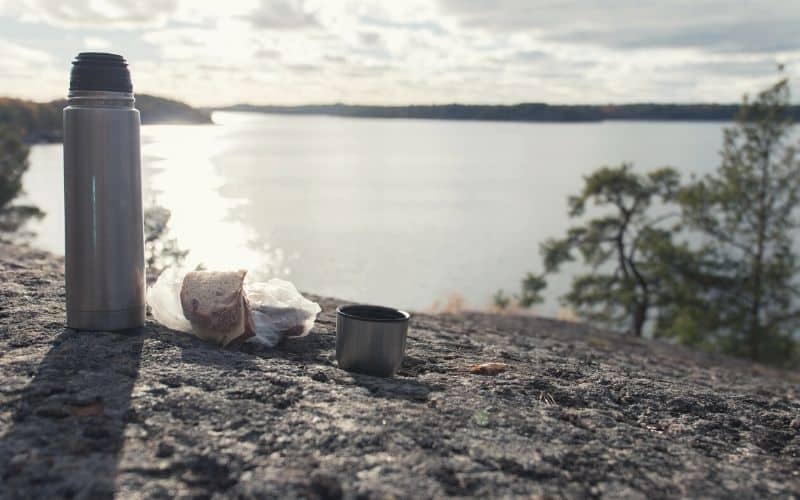
Insulation
The type and quality of insulation used in a thermos will determine its ability to retain the temperature of hot or cold contents. The two main insulation types used in flasks are foam and vacuum, with vacuum insulation being the more effective of the two.
Models that use vacuum insulation have a double-wall construction that is vacuum-sealed, meaning there’s no air between the two layers. This provides a more robust buffer against ambient temperatures and helps keep the flask’s contents at the desired temperature.
All of the products we reviewed have double-wall construction, making them highly effective insulators.
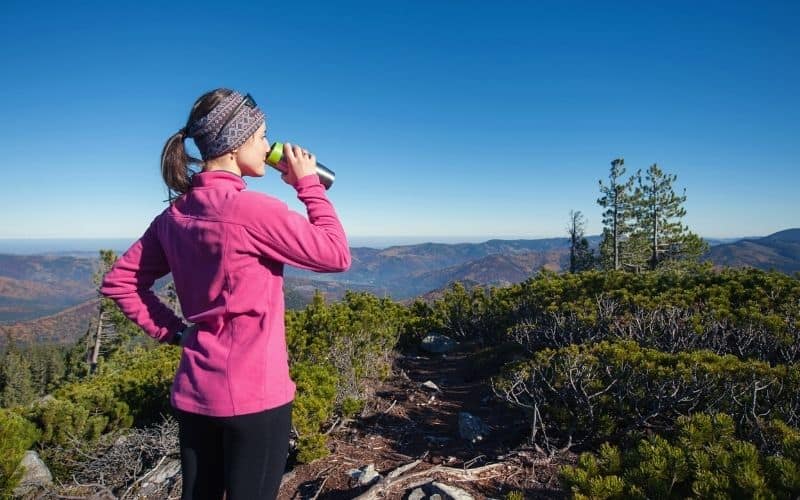
Durability
For outdoor adventures, the durability of your thermos is crucial since there is the potential for a bit of rough treatment. Dings or punctures can compromise the thermo-regulation capacity of a thermos, so the tougher the materials used, the better!
In our experience, the most durable and ding-resistant material is 18/8 stainless steel, though other options such as plastic or glass are available for buyers who’d prefer a lighter carry or something more sustainable.
Below, we’ve included a short overview of each material to help you decide which is right for you.
Stainless Steel
The main characteristics of stainless steel for use as a thermos flask are outlined below.
- Durable
- Free from all forms of leaching
- Prone to dents and scratches (less so if powder-coated)
- Heavy
- Can be pricey
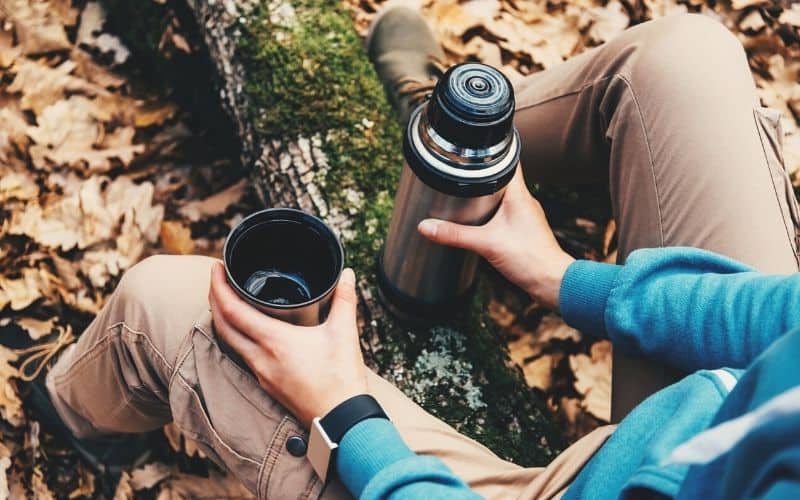
Plastic
The main characteristics of plastic for use as a thermos flask are outlined below.
- Lightweight
- Cheap
- Most are BPA-free
- Often have a plasticky smell/taste
Glass
The main characteristics of glass as a thermos flask are outlined below.
- More sustainable option
- No metallic or plasticky taste
- Prone to breaking and shattering
- Heavy
Leak Proofing
Most flasks and thermoses claim to be “leakproof.” However, some models remain leak-free only when kept upright and can be prone to leaking when shaken or tipped sideways. In our experience, the most leak-resistant bottles are those with screw-on lids minus any pour holes or spouts.
In this review, we’ve carefully selected models that are time- and trail-tested to remain leak-free, even when exposed to a little rough and tumble on our hikes.
But what makes a lid “drink-friendly”?
While this is largely a matter of personal taste, we find that wide-mouth lids are generally the easiest to drink from because of the increased flow rate. Some users, however, prefer a narrow mouth opening or drinking spout that reduces flow rate and, thus, also the risk of spillage while drinking.
Spills, of course, are no fun. Not only can they soak your gear and deprive you of your mid-hike refreshment, if you’re carrying anything other than water they can leave your pack with a virtually life-long, immovable stench. And of course, if you’re carrying hot liquid, an imperfect lid could also result in some serious burns.
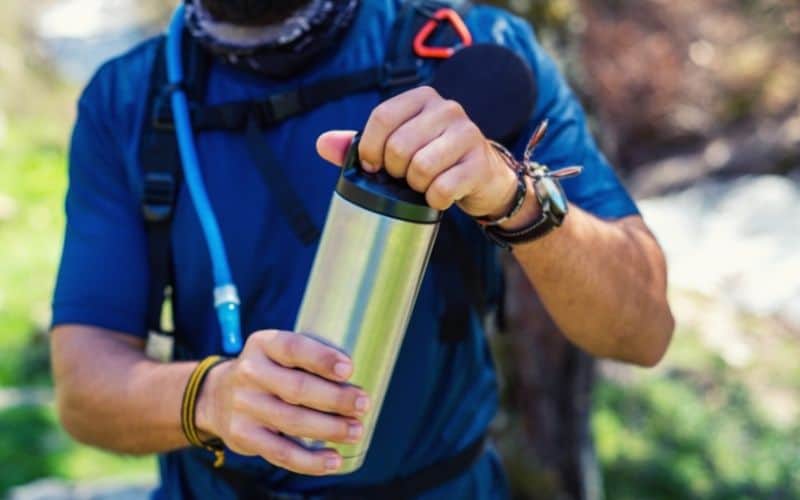
Extra Features & Accessories
A few features can significantly enhance a thermos’s convenience and practicality. We’ve compiled the most important into the following list.
- “Easy-grip”
- Multiple Lids
- Carry strap
- Exterior Cover
- Built-in Spoon
“Easy-grip”
Easy grip design features provide a better hold on the flask, preventing slips and drops, crucial when dealing with hot beverages!
To improve handling some flasks, like the Primus Trailbreak EX, use a tapered design. Most stainless steel models on the other hand use a powder coating. The Hydro Food Flask and Healthy Human Stein are good examples of this.
Multiple Lids
The option to switch out your lid for multiple lid alternatives allows you to customize your thermos according to your drinking preferences or the type of beverage in the flask. For water, a wide-mouth lid that’s easy to drink from might be a better option, while for hot drinks, a lid with a pour-hole can be more suitable since it minimizes heat loss when opened.
If your flask lid doubles as a cup, all the better! This may seem like a small add-on, but an integrated lid cup will save you having to carry a separate one, thereby saving a cup-sized amount of pack space!
Both the Primus Trailbreak EX and KK TKWide have multiple lid options, while the Trailbreak EX, Stanley Classic, Thermos Food Jar, and Thermos Compact have lids that double up as a cup.
Carry strap
A handy carry strap or handle makes it much easier to transport your flask and reduces the risk of pouring liquids on your hand when refilling.
Exterior Cover
Some vacuum flasks feature an exterior cover for additional protection against dings or to prevent freezing your fingers during use on cold days. The Primus Trailbreak EX Vacuum Bottle, for instance, comes with an added silicone cover.
Built-in Spoon
If soup, stew, or any other more solid edible is among your favorite trail-time eats, then a handy built-in spoon will save you from having to carry separate cutlery. In our review, only the Thermos Food Jar has a built-in spoon.
If soup, stew, or any other solid food is a favorite on your trail adventures, a convenient built-in spoon will spare you the need to pack separate cutlery. Of the insulated food containers in our review, only the Thermos Food Jar comes equipped with a built-in spoon.
